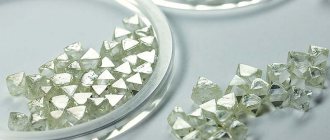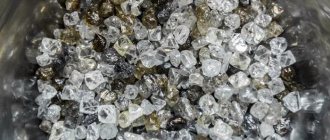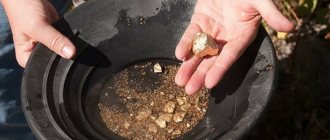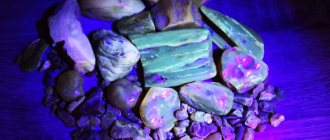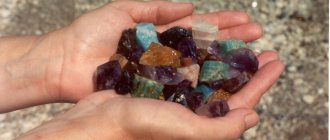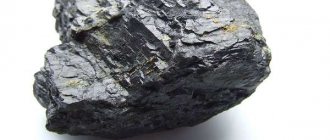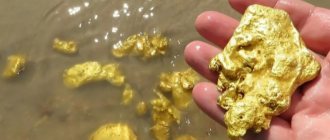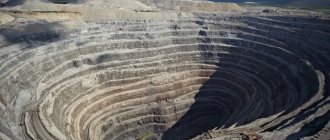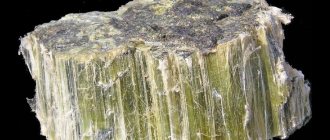- Home page
Diamond got its name from the ancient Greek “ἀδάμας”, which translated meant “indestructible”. You can often find mention of the nationality or territorial affiliation of the stone - Indian, Yakut, Australian. The indication of a mining location usually has a set of certain characteristics, because the territories differ in geological conditions and soil composition. The value of diamonds depends not only on volumes; the purity of the stones, their weight, and the uniqueness of their color also play a role. Large, clean, flawless stones are valued on par with works of art and given names. Such finds became a national treasure and the pride of the owners.
Leading countries in diamond production
Industrial mining of rough and polished diamonds is carried out on all continents, with the exception of Antarctica. The discovery of a diamond deposit on the territory of a state is a guarantee of economic growth and development. 70% of global diamond production today comes from 3 corporations:
- Russian ALROSA (Russian Diamonds – Sakha);
- the international corporation De Beers, which owns fields in South Africa;
- Australian-British concern Rio Tinto Group.
ALROSA is the leader in production volumes, but based on the total cost of mined rough diamonds, De Beers is considered the leader.
- Until recently, Australia was among the leaders, but its mines with rare pink crystals have been depleted.
- South Africa is the only state on the “Dark Continent” that is not a third world country. About 7.4 million carats of diamonds are mined here every year.
- Angola with the Fucauma field. Mines 8.7 million carats of diamonds per year.
- Canada is a leader in terms of import and export volumes. The main deposit is Ekati. The annual volume of mined diamonds is 12 million carats.
- Botswana is the leader in the number of diamond mines. The country produces 24.6 million carats per year.
- Russia - 38.3 million carats, the leader in diamond production volumes.
Despite the UN initiative and the organization of the Kimberlite Process, the supply of smuggled diamonds from African countries still continues. Funds from the sale of stones go to support military conflicts in the region.
In Russia, diamond mining is under state control. To start mining gems, you need to obtain a special license. Diamonds are a source of income for the treasury, a guarantor of financial independence. Our country has all the prerequisites to switch to exporting already cut stones, which would increase income.
Fourth place. Republic of South Africa (SA). $1.3 billion
Diamonds in South Africa
South Africa today has the status of the most developed on the African continent and at the same time the only country that does not belong to the third world. As of 2009, this country’s GDP amounted to $505 billion (and this is 26th place in the world). At the same time, in 2009, GDP growth was noted at 5%, and in 2008 the figure was 3%. The country has not yet been able to become one of the most developed countries in the world, even despite the fact that the state market is expanding incredibly actively. According to such an indicator as purchasing power parity, the country ranks 78th in the world (IMF data), 65th (according to the World Bank) and 85th according to the CIA. The country boasts a huge reserve of various natural resources, including diamonds.
Large diamond deposits
99% of diamonds mined in Russia are obtained from deposits in Yakutia. Previously, stones were found in the Urals - on the banks of streams and rivers, as well as during washing of gold ore. However, the placers were practically not given the opportunity to begin industrial development.
Depending on the geological processes involved in the removal of diamond ore to the upper layers, deposits are divided into impact, bedrock and placer deposits.
Impact diamonds appear on the surface as a result of a meteorite falling. Such deposits are not always suitable for industrial production, but they are of significant interest to scientists.
Primary deposits are those that formed where magma reaches the surface. Most often these are deposits in areas with seismic activity and active or dormant volcanoes. Kimberlite and lamproite pipes are vertically oriented geological bodies that expand due to the explosion of rock at the outlet. The predominant volume of production is carried out in kimberlite deposits. Most of the jewelry stones are mined from them.
A placer deposit is formed as a result of erosive processes in a diamond-bearing pipe. Precipitation washes away the rock, forming placer fields of diamonds, pebbles and rubble.
Placer diamond deposits are divided into 4 types.
- Coastal-marine - when volcanic rock crumbles on the coast.
- Colluvial - formed on slopes.
- Alluvial - formed in river valleys.
- Eluvial - placers in the upper layer of the earth.
For thousands of years, placers have been the subject of industrial diamond mining. It was even believed that diamonds were formed in rivers.
The largest diamond deposits are recognized in descending order of rating:
- Jwaneng (Botswana);
- Yubileiny (Russia, Yakutia);
- UDACHNOE (Yakutia);
- Mir (Yakutia);
- Argyll (Australia);
- Catoca (Angola);
- Venice (South Africa);
- Deposit named after V.P. Grib (Russia, Arkhangelsk region);
- Orapa (Botswana).
Also considered to be large deposits are the Russian Botuobinskoye, named after M. Lomonosov; Crater of Diamonds State Park in the USA; Indian mines of Panna, Brazilian Minas Gerais.
Interesting Facts ?
These stones have always adorned the crowns of kings and emperors.
The Raja of Maltan diamond has never been cut. It is considered one of the most mysterious and famous stones. It was credited with the properties of preserving the well-being of the country where the stone is located.
When Louis XV ascended the throne, an unusual crown adorned his head. It contains 282 diamonds, including the famous Regent diamond, many pearls and precious stones. The top of the crown is not a traditional cross, but a diamond flower.
The diamond caps of Peter I and Ivan V are literally strewn with diamonds. (Singaevsky. “The most legendary jewels of the world...”).
Diamonds are the hardest material on Earth: 58 times heavier than anything else in nature.
"LUCY" - This star is located fifty light years from Earth and is a diamond weighing 10 billion trillion trillion carats.
The average yield from most diamond mines is 1 part diamond per 1 million parts host rock.
In 2005, Natalia Dubrovinskaya was able to grow an artificial “hyperdiamond” at the University of Heidelberg, the hardness of which is 11% higher than that of natural stone.
There are several well-known alternatives to natural minerals: moissanites, cubic zirconia, ASHA diamonds, HPHT diamonds.
The first diamond deposits were discovered on the banks of the Indus and Ganges, and 4,500 thousand years ago in the territory of modern China, diamonds were used to sharpen battle axes.
99% of all diamonds mined in the vastness of Russia come from the deposits of Yakutia.
The romantic and creative inhabitants of Ancient Greece associated diamonds with the transparent tears of the gods, and Greek philosophers argued that these were fragments of stars falling to the Earth.
80% of all diamonds on earth are used for drilling, cutting, grinding and polishing various surfaces.
The Mir quarry is so large that the air currents generated above it can swallow a helicopter into the depths of the mine.
History of the discovery of diamonds
The ancient Indians were the first to discover diamonds. For several thousand years they were the only ones who mined this gem. It was only in the 2nd century that stones began to be exported from India to China. In the 6th century, diamond placers were discovered on the island of Kalimantan. In the 3rd century BC, diamonds were brought to Europe with Alexander the Great.
- Diamond ores were discovered in Brazil in 1725.
- The first diamonds were discovered on the territory of the Russian Empire in 1829.
- The South African diamond deposit was discovered in 1868.
Today, diamonds are also mined in Botswana, Zaire, Namibia, Canada, and Angola.
Primary diamond deposits in Yakutia were discovered only in the mid-1950s. The discovery of the Zarnitsa, Mir and Udachnaya kimberlite pipes marked the beginning of industrial diamond mining in the USSR. The highest quality diamonds in Russia today are mined in the Ural diamond-bearing province.
Ore extraction methods
You can extract rough diamonds from crushed ore using several proven recipes.
- Suspension (fossil masses are placed in a dense liquid - diamonds, although the hardest, are also the lightest - they are quickly discovered, floating to the top).
- Grease (the smooth surface of the unloaded mined ore is smeared with grease and then subjected to water pressure - the diamonds will stick and everything else will be carried away).
- The action of X-rays perfectly shows the reflections of diamonds. But the method is dangerous for people.
- A magnet, on the contrary, reacts to everything except diamonds. It attracts metals from the array.
- Separation using electric current allows you to distribute the contents into several fractions at once. Each metal falls on its own “path”, and the diamond – on its own. After all, he is also a conductor. Voltage (like X-rays) is dangerous for people.
Leading diamond mining countries use all methods of solid carbon extraction.
Origin of diamonds
There are several theories explaining the origin of the strongest minerals. All of them are divided into 2 groups - cosmic and terrestrial.
When ancient Greek philosophers called diamonds fragments of fallen stars, they were somewhat right. Some of the diamonds found on our planet appeared here through meteorites. After the fall of a celestial body, diamond placers are discovered in the craters. Among scientists, they are considering versions that put forward the following hypotheses:
- a meteorite is a fragment of a larger celestial body, which contained diamond ore in its rock;
- the second hypothesis is that the carbon in the meteorite, when colliding with other meteorites, or when passing through the earth’s atmosphere and falling, is subjected to high pressure and temperature, due to which the molecular lattice crystallizes into a diamond one.
Such diamonds are called shock or impact diamonds. The probability of finding a stone with jewelry value in this case is almost impossible, the grain diameter is too small.
Terrestrial theories of the origin of diamonds are based on the effect of temperature and pressure formed by magma on carbon. The so-called kimberlite pipes, which are the cradle of diamonds, are nothing more than a place where magma comes to the surface.
The very best stones?
Diamond is the only mineral on earth consisting of a single element. This is carbon.
The same one from which leads for simple pencils are made. The difference between lead and diamond is the “packaging” of the crystal lattice.
Quality factors?️
The human contribution to the beauty of a diamond is a well-executed cut.
